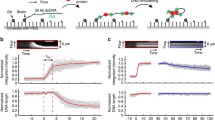Abstract
Single molecule fluorescence imaging incorporated with optical tweezers and a laminar flow cell has been used to monitor the kinetic process of DNA condensation induced by spermidine. It was found that at least two steps were involved in the condensation process of the hydrodynamically-stretched linear DNA; a lag period followed by a rapid collapse of DNA. The lag time increased with the flow speed and the collapse time remained short within the range of the flow speed studied. The effect of salt concentration on the condensation process was examined, and the results suggest that the longer lag time observed in the higher salt buffer probably results from the displacement of bound cations and rearrangement of spermidine on the DNA. The flow-speed dependence of the lag time suggests that a nucleation event at the free end of the DNA, i.e. formation of a loop, may play a vital role in the kinetic process of condensation.
Similar content being viewed by others
REFERENCES
S. Weiss (1999). Fluorescence spectroscopy of single biomolecules. Science 283, 1676-1683.
A. Ishijima and T. Yanagida (2001). Single molecule nanobioscience. Trends Biochem. Sci. 26, 438-444.
Y. Ishii, A. Ishijima, and T. Yanagida (2001). Single molecule nanomanipulation of biomolecules. Trends Biotechnol. 19, 211-216.
A. E. Knight, C. Veigel, C. Chambers, and J. E. Molloy (2001). Analysis of single-molecule mechanical recordings: application to acto-myosin interactions. Prog. Biophys. Mol. Biol. 77, 45-72.
C. G. Baumann, V. A. Bloomfield, S. B. Smith, C. Bustamante, M. D. Wang, and S. M. Block (2000). Stretching of single collapsed DNA molecules. Biophys. J. 78, 1965-1978.
P. R. Bianco, L. R. Brewer, M. Corzett, R. Balhorn, Y. Yeh, S. C. Kowalczykowski, and R. J. Baskin (2001). Processive translocation and DNA unwinding by individual RecBCD enzyme molecules. Nature 409, 374-378.
L. R. Brewer, M. Corzett, and R. Balhorn (1999). Protamine-induced condensation and decondensation of the same DNA molecule. Science 286, 120-123.
V. A. Bloomfield (1996). DNA condensation. Curr. Opin. Struct. Biol. 6, 334-341.
V. A. Bloomfield (1997). DNA condensation by multivalent cations. Biopolymers 44, 269-282.
N. Makita and K. Yoshikawa (2002). Proton concentration (pH) switches the higher-order structure of DNA in the presence of spermine. Biophys. Chem. 99, 43-53.
R. Golan, L. Pietrasanta, W. Hsieh, and H. G. Hansma (1999). DNA Toroids: stages in condensation. Biochemistry 38, 14069-14076.
N. V. Hud and K. H. Downing (2001). Cryoelectron microscopy of lambda phage DNA condensates in vitreous ice: the fine structure of DNA toroids. Proc. Natl. Acad. Sci. U.S.A. 98, 14925-14930.
V. Vijayanathan, T. Thomas, A. Shirahata, and T. J. Thomas (2001). DNA condensation by polyamines: A laser light scattering study of structural effects. Biochemistry 40, 13644-13651.
L. D. Murphy and S. B. Zimmerman (1995). Condensation and cohesion of λ DNA in cell extracts and other media: Implications for the structure and function of DNA in prokaryotes. Biophy. Chem. 57, 71-92.
E. Raspaud, M. Olvera de la Cruz, J.-L. Sikorav, and F. Livolant (1998). Precipitation of DNA by polyamines: A polyelectrolyte behaviour. Biophys. J. 74, 381-393.
B. Ladoux, J. Quivy, P. Doyle, O. du Roure, G. Almouzni, and J. Viovy (2000). Fast kinetics of chromatin assembly revealed by single-molecule videomicroscopy and scanning force microscopy. Proc. Natl. Acad. Sci. U.S.A. 97, 14251-14256.
S. Matsuura, J. Komatsu, K. Hirano, H. Yasuda, K. Takashima, S. Katsura, and A. Mizuna (2001). Real-time observation of a single DNA digestion by λ exonuclease under a fluorescence microscope field. Nucleic Acids Res. 29, e79.
R. W. Wilson and V. A. Bloomfield (1979). Counterion-induced condensation of deoxyribonucleic acid. A light-scattering study Biochemistry 18, 2192-2196.
B. Ostrovsky and Y. Bar-Yam (1995). Motion of polymer ends in homopolymer and heteropolymer collapse. Biophys. J. 68, 1694-1698.
C. Bustamante, T. W. Houseal, D. Beach, and M. F. Maestre (1990). Fluorescence microscopy of the dynamics of supercoiling, folding and condensation of bacterial chromosomes, induced by acridine orange. J. Biomol. Struct. Dyn. 8, 643-655.
Author information
Authors and Affiliations
Corresponding author
Rights and permissions
About this article
Cite this article
Su, TJ., Theofanidou, E., Arlt, J. et al. Single Molecule Fluorescence Imaging and Its Application to the Study of DNA Condensation. Journal of Fluorescence 14, 65–69 (2004). https://doi.org/10.1023/B:JOFL.0000014661.89050.1b
Issue Date:
DOI: https://doi.org/10.1023/B:JOFL.0000014661.89050.1b




